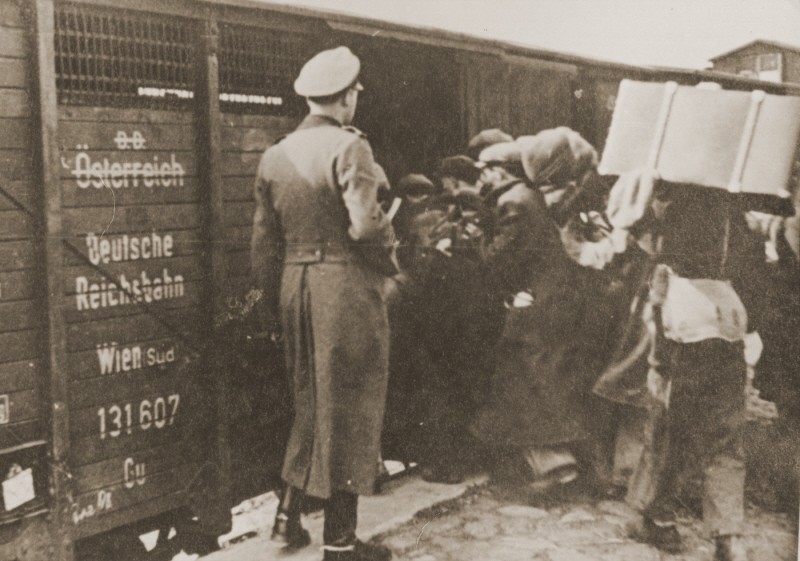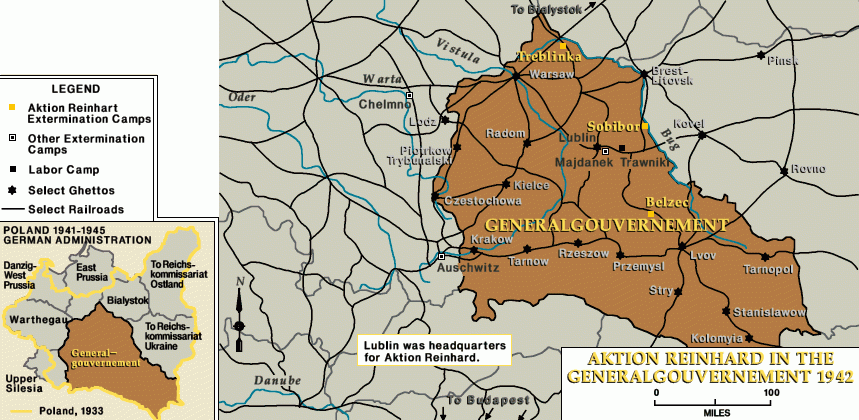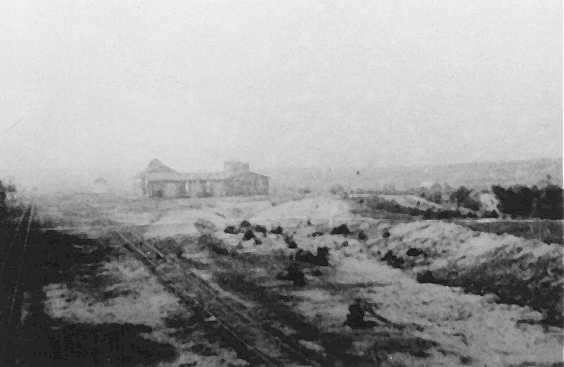
Belzec: Key Dates
To carry out the mass murder of Europe's Jews, the SS established killing centers devoted exclusively or primarily to the destruction of human beings in gas chambers. Belzec was among these killing centers. It was one of three killing centers linked to Operation Reinhard, the SS plan to murder almost two million Jews living in the German-administered territory of occupied Poland called the General Government.

1939–1941
On November 1, 1939, Heinrich Himmler appoints SS General Odilo Globocnik to the position of Lublin District SS and Police Leader. Himmler is Reich Leader of the SS and Chief of German Police. On July 17, 1941, he appoints Globocnik as Commissioner for the Establishment of SS and Police Bases in the Occupied Eastern Territories. In early autumn of that year, Himmler tasks Globocnik with organizing the mass murder of Jews residing in the General Government (Generalgouvernement). This operation later becomes known as Operation Reinhard (also called Aktion Reinhard or Einsatz Reinhard). The effort was named for Nazi official Reinhard Heydrich, who died following an assassination attempt in June 1942. Heydrich was a key architect of the “Final Solution.” Three killing centers—Belzec, Sobibor, and Treblinka—are constructed for the sole purpose of murdering Jews. Between March 1942 and November 1943, the personnel of Operation Reinhard kill approximately 1.7 million Jews in the three camps and related shooting operations.
November 1, 1941
Under the supervision of the camp’s first commandant, Christian Wirth, Polish civilian workers begin construction of a killing center on the outskirts of Belzec in southeastern Poland. The site is located along a major rail line. This line connects the large Jewish population centers in and around Lvov (today Lviv), Krakow, and Lublin. Belzec is the first Operation Reinhard killing center to become operational. Most of the German staff have been recruited from the “euthanasia” program (Operation T4). Operation T4 was the Nazis’ first program of systematic mass murder that targeted patients with disabilities on German soil. Thus, some Belzec staff have previous experience in a killing program. The gas chambers are constructed in a wooden building. They operate using carbon monoxide gas from the exhaust fumes of a motor vehicle engine. In February 1942, SS and police personnel and Trawniki-trained guards murder small groups of Jews deported from towns near Belzec. They carry out these killings to test the efficacy and capacity of the gas chambers. By March 1942, the camp is ready for mass killing operations.
March 17, 1942
The systematic mass murder of Jews begins in Belzec with deportations from the city Lublin. These deportations are the first to be carried out within the framework of Operation Reinhard. By April 14, 1942, German authorities will kill nearly 30,000 of the 37,000 Jews of Lublin and about 15,000 Jews from Lvov. During the summer of 1942, the SS and police will deport over 120,000 Jews from the Krakow district to Belzec. Between March and June 1942, the Germans kill an estimated 85,000 Jews in the Belzec killing center.
June 19, 1942
The first phase of gassing operations ends at Belzec after the arrival of over 11,000 Jews from the city Tarnow. Operation Reinhard authorities in Lublin halt deportations in order to replace the wooden building that houses the gas chambers with a more substantial structure. SS and police authorities construct a larger building with six gas chambers. These new gas chambers enable the camp authorities to kill up to 1,500 people at one time. The six gas chambers begin operations in July. Like the original chamber, they use carbon monoxide gas from the exhaust fumes of a motor vehicle engine.
July 7, 1942
Deportations to Belzec resume. During this phase, the SS and police deport around 350,000 Jews from Krakow, Lublin, and Lvov Districts to Belzec.
July 10, 1942
Polish underground officials in occupied Poland send a report to the Polish government-in-exile in London. This report details the killing process in the Belzec camp. Polish underground organizations also send out reports about all Operation Reinhard camps. These reports are received by Jewish organizations, the Polish government-in-exile in London, the British government, and other Allied organizations in western Europe. Many of the reports are met with doubt and distrust. As a result, little or no action is taken to warn Jews still in ghettos about the camps.

August 1, 1942
Gottlieb Hering replaces Christian Wirth as commandant of the Belzec camp. Like Wirth, Hering comes to Operation Reinhard from the “euthanasia” program. Hering will remain camp commandant until the liquidation of the camp in 1943.
August 19, 1942
SS official Kurt Gerstein inspects Belzec. Gerstein is an official of the Institute of Hygiene of the Waffen SS in the SS Operations Main Office. He checks the efficiency of carbon monoxide as a gassing agent in the Operation Reinhard camps. Gerstein later leaks a detailed report in an effort to make Allied and neutral circles aware of the Holocaust. He sends the report to Swiss and Swedish diplomats, Catholic church officials, and the Dutch government-in-exile.
December 1942
The Operation Reinhard authorities halt deportations to Belzec. By this time, German authorities have killed approximately 434,500 Jews in the Belzec killing center.

